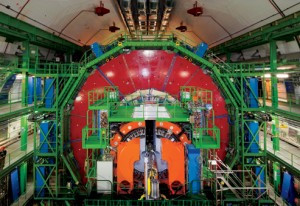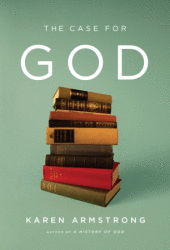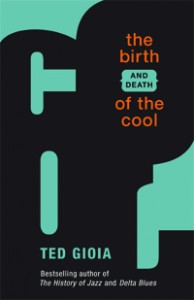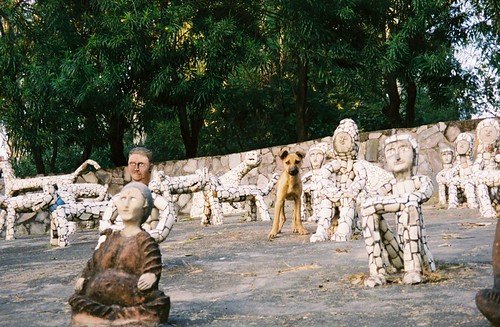See more of these wonderful 18th-Century illustrations (and much more) at the intriguing blog BibliOdyssey.
Sad news: Bannerman’s Castle on an island in the Hudson River is crumbling

Bannerman’s Castle was already an enigmatic ruin in the middle of the Hudson River, a dreamy landmark for passing train travelers and a passionate cause for preservationists.
But then in the silence of last Saturday night, a large chunk of history suddenly disappeared when the castle’s stone, brick and cement sighed under a century’s weight of weather. Overnight, two-thirds of the eastern tower was gone, as well as one-third of the adjacent southern wall, leaving a gaping hole and concern over how to stop the crumbling.
Read more: nytimes.com
[via @marklamster]
Chandigarh, India: The Rock Garden
A dog among the sculptures in Nek Chand’s Rock Garden in Chandigarh, India.
A non-scientist’s mash note to the Large Hadron Collider

We need more science writing like this… Kurt Andersen’s appreciative essay in Vanity Fair about the Large Hadron Collider:
The believe-it-or-not superlatives are so extreme and Tom Swiftian they make you smile. The L.H.C. is not merely the world’s largest particle accelerator but the largest machine ever built. At the center of just one of the four main experimental stations installed around its circumference, and not even the biggest of the four, is a magnet that generates a magnetic field 100,000 times as strong as Earth’s. And because the super-conducting, super-colliding guts of the collider must be cooled by 120 tons of liquid helium, inside the machine it’s one degree colder than outer space, thus making the L.H.C. the coldest place in the universe.
Read more of Kurt Anderson’s exciting interpretation at Vanity Fair.
Polaroid film: A 1972 “introduction” by Charles and Ray Eames
So serious–artistically and technically–for what is basically just an advertisement!
This short film is intrinsically interesting because it was made by the iconic designers Charles and Ray Eames, but it’s also fascinating as a time capsule of 1972… as a technical lesson on how a wonderful invention worked… and as a reminder of why–even in our age of instantly sharable digital imagery–people still desire this kind of tangible photography.
[Video found via Merlin Mann]
Note: The above YouTube version is inferior to a Vimeo version that I first posted. Unfortunately, it seems to have disappeared. If I can rediscover the better rendition, I’ll repost it.
Brian Eno says farewell to the uncool
It almost sounds as though Brian Eno has been reading Ted Gioia. Here’s Eno on “the death of uncool”:
We’re living in a stylistic tropics. There’s a whole generation of people able to access almost anything from almost anywhere, and they don’t have the same localised stylistic sense that my generation grew up with. It’s all alive, all “now,” in an ever-expanding present, be it Hildegard of Bingen or a Bollywood soundtrack. The idea that something is uncool because it’s old or foreign has left the collective consciousness.
I think this is good news.
Read more from Brian Eno at Prospect.
The Vivid Imperial Scrolls of China
 Imagine waking one morning as heir to a major share of the planet:
Imagine waking one morning as heir to a major share of the planet:
“In 1689, Kangxi, the emperor of China, embarked on a tour to inspect his southern provinces, undertaking a two-thousand-mile journey from Beijing to the cities and towns of the Yangzi Delta and back…”
Read more about the Imperial scrolls at Humanities magazine.
Karen Armstrong’s Case for God

Religion poisons everything… God is a delusion… the end of faith… these are phrases lately found among the burgeoning supply of books by “new atheists” who take arms against a sea of holy rollers and jihadis. In an age of faith-based politics, resurgent creationism, and religious terrorism, aggressive atheists like Richard Dawkins, Sam Harris, and Christopher Hitchens have become bestselling authors.
A new book attempts to take a stand against both the religious fundamentalists and their militant atheist foes. The Case for God is a landmark work of intellectual and theological history by the renowned scholar of religion Karen Armstrong.
The book is nothing less than a comprehensive history of human religion in just over three hundred pages. From painted traces of Paleolithic hunter-shamans on the Lascaux Cave walls to hip postmodernist theology, Armstrong offers a lucid narrative of humanity’s relationship with the divine. In her telling, the story of God and man unrolls like an ancient tapestry richly embroidered with scholarly insights and references from the world’s many religious traditions.
It is a compelling story, but it isn’t clear that many people—secularists or religionists—will find it persuasive.
Read the rest of my review of The Case for God at The Book Studio.
“The Second Vision” – A Lovely HD Video
Fragments of test footage and moments in life and nature, beautifully edited into a short film by Martin Lang – composed of random clips filmed over five months on location in Sweden.
The accompanying song is “Nut in Your Eye” by Alcoholic Faith Mission.
Ted Gioia on the Birth and Death of the Cool

Has coolness runs its course? Are we living in a post-“cool” culture?
Musician and writer Ted Gioia talks about his new book, The Birth and Death of the Cool in episode 102 of The New Modern podcast. You can listen using the embedded player above or via iTunes. Please consider leaving a review and subscribing (for free) to future New Modern podcasts in the iTunes store.
Renowned for his important books about music, especially his History of Jazz, Ted Gioia is a prolific culture writer and literary critic.
Scott Timberg, the Los Angeles writer (and a pretty cool guy), recently posted a Q&A with Gioia on his new book. Though many will find much to disagree with in Gioia’s arguments, there’s a unquestionably a new fashion for authenticity and sincerity.
Whether that spirit marks the death of “cool” in the sense that Ted Gioia means it, remains to be seen. Listen to our interview, read the book, and decide for yourself.
[Watch this space for additional links and a full transcript.]

